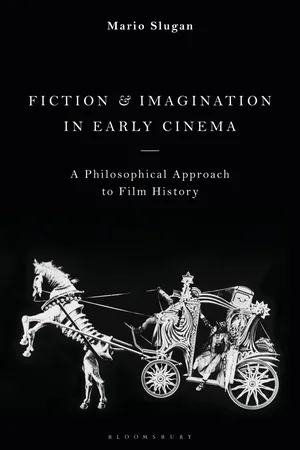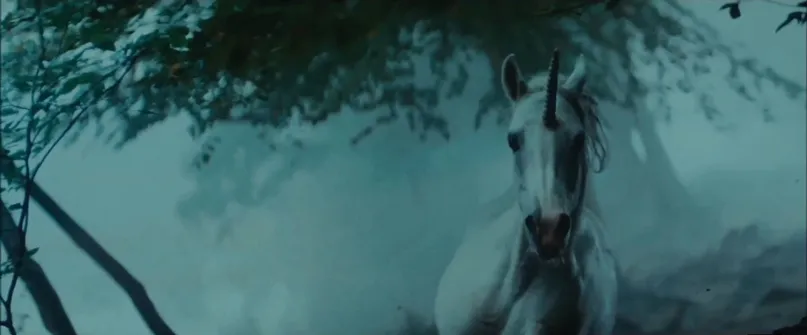![]()
1
The status of fiction in early cinema: Train and trick films
Are there textual criteria for fictionality?
As Charlie Keil reminds us, film historians used to regularly cite the films of Lumière brothers and Georges Méliès as incontestable evidence of the existence of two competing tendencies since the earliest days of cinema – fiction and non-fiction.1 More precisely, they distinguished between fiction and documentary (a category narrower than non-fiction film), but given that the key trait of documentaries for these historians was precisely their non-fictional nature, it was the non-fiction/fiction binary opposition that organized these histories. Since the advent of new film history, however, this founding dichotomy has been questioned on at least two fronts. On the one hand, scholars such as Tom Gunning have argued that the early cinema was perceived primarily in terms of attractions rather than the distinction between fiction and non-fiction.2 On the other, Keil has claimed that although the categories of fiction and non-fiction were not unimportant during this period the line between the two was not as clear-cut as the earlier generations of film historians had us believe.3
In this chapter my aim is to probe further into the question of relevance of the categories of fiction and non-fiction for early film history. More specifically, my guiding questions will be: what were the early cinema audiences mandated to make-believe? What were they expected to believe? What were they tricked into believing? What could they but disbelieve? Next to allowing us to articulate some of the key aspects of early cinema, these questions will also allow me to address wider concerns about the nature of fiction in general. Primarily, I will be interested in historicizing Kendall L. Walton’s notion of make-believe by answering, on the example of early cinema, where the mandates to use representations as props for imaginings come from in the first place.4 From the perspective of analytic philosophy, this will allow us to better explain how fictional status is attributed to representational works. In other words, it will reveal how in this process factors such as film reception and exhibition context play as important a role as intention and textual features do. From the perspective of new film history, this investigation will reveal the importance the notion of imagination played in the promotion and reviews accompanying early cinema. More specifically, it will force us to reconsider standard categorizations of exemplary early cinema genres – Méliès trick films and Lumière brothers’ train films – in terms of fiction and non-fiction.
Regardless of whether the importance of categories of fiction and non-fiction is downplayed as in the case of cinema of attractions or their boundaries made more permeable, new film historians appear to assume that it is the textual features that determine whether something is fiction, non-fiction or something in between. In their introduction to American Cinema, 1890–1909 Gaudreault and Gunning, for instance, distinguish between fiction films and actualities (understood as early non-fiction film):
Both are described in reference to the content they depict; whereas actualities depict everyday events, acrobatic feats, views of various locales and the like, fiction films include trick films, gag comedies, chase films and so on. Such focus on textual features as the defining trait of the status of both fiction and non-fiction is typical not only of how other volume’s contributors apply the terms in question but also of the more detailed taxonomy provided in the thematic entry list in Richard Abel’s Encyclopedia of Early Cinema.6 Next to actualities, non-fiction films, for instance, also include content-defined genres such as phantom train rides, travelogues, boxing films and so on.
Detailed discussions of what counts as fiction in early cinema are rare. One exception is Keil but even he is only sceptical about the applicability of the Lumière/Méliès dichotomy to the whole of early cinema and its definability in terms of content.7 In the case of The Arrival of a Train/L’Arrivée d’un train en gare de La Ciotat (1897)8 and A Trip to the Moon/Le Voyage dans la Lune (1902) he, however, does not dispute ‘the obvious differences between the engine of steam and steel pulling into Ciotat station and the cardboard rocket hurtling toward a papier-mâché moon’.9 Keil continues: ‘we can distinguish fiction films from nonfiction by the means of presentation rather than by content.’10 In other words, fiction/non-fiction distinction is not about what the film represents but how the film represents it (mise-en-scène, camera angle, distance, etc.). So, the distinction is less about the difference between an everyday event and a fantastical exploration of celestial bodies and more about the on-location shooting of a train as opposed to the use of theatrical props and film tricks.
Even under this modification, however, the criteria for whether something is fiction or not remain exclusively textual.11 My point, by contrast, is that there is nothing internal to the two motion pictures that would allow us to classify The Arrival of a Train as non-fiction and A Trip to the Moon as fiction. If we are to approach Lumière brothers’ film simply on the terms of its representational content and technique, what is to preclude us from taking it as a film depicting an arrival of, say, an undercover agent (hidden somewhere in the disembarking crowd) to a foreign town? Somebody sharing Keil’s view might point out that in virtue of its presentation the whole scene comes across as unstaged or, to put it in Gunning’s terms, that it exhibits the ‘view’ aesthetic – a standard trait of documentaries, a key category of non-fiction.12 Given that the film elicits an impression of an everyday train arrival with people going about their daily business we must be dealing with non-fiction. But this would imply that no fiction film can make use of non-scripted performances and on-location shooting, and that is patently false. Another objection might be that there is clearly a moment when one of the disembarking passengers looks at the camera and then quickly leaves the shot, most probably because the cameraman has asked him to do so. But how does this preclude us from engaging the film as, say, a fiction about a cameraman who has had the bad luck of somebody ruining his shot? In other words, there is no reason a fiction film could not employ any and all stylistic features usually connected with documentaries – actual locations, use of non-actors as characters, minimal or no staging and so on. The same applies for the features and presentation techniques of the broader category of non-fiction which may include the elimination of narrative structures and representational form.13
In the case of the Méliès’s film we are faced with an obverse predicament. There is undeniably a fictional story about a certain expedition to the moon that can be inferred from watching the film. There are, moreover, images of entities which clearly represent objects and agents non-existent at the time: flying rockets, humanoid Moon inhabitants and an anthropomorphic moon, just to name a few. We need not, however, immediately take this as a sign that we are dealing with a fiction film. The fact remains that all the images cited are photographic reproductions of some actual objects. Much like it is possible to entertain a photographic image of a unicorn as essentially a photographic reproduction of a horse with a horn attached to its head (Figure 1.1), it is also reasonable to think of a Moon person on screen as an actor dressed up in a suit in front of a camera. The introduction of temporal dimension in film in contrast to photography and the articulation of a narrative does not necessarily mandate any imaginings either.14 The above unicorn is still just a horse with an artificial horn attached, albeit it is now galloping around. In other words, no internal trait of the film stops us from engaging A Trip to the Moon simply as a recording of dressed-up actors playing certain characters across a number of stage-sets and scenes, a point that André Bazin has made.15 And while at it why not also simply take the shots of the cardboard rocket and the papier-mâché moon as documents of how everyday material can be used to prompt imaginings of all sorts? The idea of cinema as ‘canned theatre’ used primarily to dismiss cinema as art in the early twentieth century certainly allows for this approach.
An answer to these semi-rhetorical questions might be that, following Keil’s logic about the key role of presentation techniques in determining non/fictional status, Méliès’s film is not really an instance of ‘canned theatre’, and not even an instance of ‘canned magic theatre’ because there are clearly film specific effects in it. After all, the notion of ‘canned magic theatre’ has been criticized for decades by scholars such as Jacques Malthête.16 First, there are numerous occasions of antagonists simply disappearing from the shots clearly accomplished by means of substitution splicing. Moreover, multiple exposure plays a key role at least in the shot in which the rocket plunges from the moon back to the earth and the ocean. Finally, some prints of the film were hand-coloured so at least in some versions there are objects other than those reproduced by the camera that contribute to the representational content. Allow me to address these concerns in order. The use of substitution splicing does not change the fact that the shots across the splice are of actual objects – the first with the actor dressed up as a Moon inhabitant and the second without him. Nothing changes as far as the option to engage the film as a recording of actual people participating in a game of make-believe about a mission to the moon. Though the technique can certainly aid us in imagining that hitting a Moon person over the head with an umbrella will make him disappear, we are still perfectly free to regard the scene as a great example of how actors are able to stand perfectly still as one of them departs the shot and then continue performing once the cameraman has started shooting again. Multiple exposure presents no problem for similar reasons. Again it is from actual objects that the photographic images are derived – that they are composed into a single image only documents how film can make it look like a rocket is falling into an ocean, though from our perspective it is really a matter of juxtaposing a cardboard rocket against a stock footage of the sea and then having the former move towards the lower edge of the frame as the shot progresses. In other words, we can treat this as a combination of stop-motion animation and multiple exposure. The colour, admittedly, is not a result of shooting anything in front of the camera but a matter of adding pigments onto the filmstrip itself. Moreover, it is undeniable that, as Gunning and Joshua Yumibe have explained, colour in early cinema was used for fantastical effects and as an attraction in itself mo...

